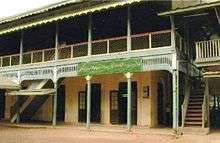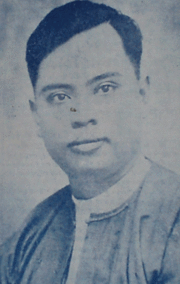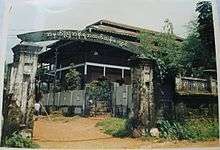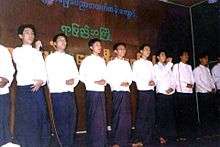Basic Education High School No. 9 Mawlamyine
| Shin Maha Buddhaghosa High School | |
|---|---|
|
School in the 1990s | |
| Address | |
|
Pabedan Street Mawlamyaing, Mon State Myanmar | |
| Information | |
| Type | Public |
| Established | 1899 |
| Founder | Sāsanādhāra Society |
| School number | 9 |
| Principal | Dr. Hla Hla Maw |
| Grades | 1-11 |
| Number of students | ~2500 |
Basic Education High School No. 9 Mawlamyaing (Burmese: အခြေခံ ပညာ အထက်တန်း ကျောင်း အမှတ် (၉) မော်လမြိုင်; commonly known by its colonial name, Shin Maha Buddhaghosa National School (Burmese: ရှင် မဟာဗုဒ္ဓဂေါသ အမျိုးသား ကျောင်း) is located on Pabedan Street, Mawlamyaing.[1]
Founded by the Sāsanādhāra Society in 1899 during the British colonial period, the school produced notable writers and politicians who played a role in the Burmese independence movement. Today, the school remains one of the most prestigious high schools in the city. It maintains a diverse student body consisted of students from various financial and ethnic backgrounds.
History
Background
Before the British colonial period, the education system in Burma was primarily driven by Buddhist monasteries at least since the 11th century. The Buddhist monastic school system gave Burma a literacy rate considerably higher than those of other Asian countries in the early 1900s. In the colonial period, the British administration and Christian missionaries founded Western education centers including St. Patrick's School (now B.E.H.S No.5) in Moulmein. In 1869 in Lower Burma, there were 340 "Lay Schools" with 5069 students, providing basic Western education. In comparison, 3438 monastic schools were operating in the region, providing Buddhist education to over 44,000 students.[2] Traditional methods of teaching, however, became obsolete in the British colonial environment. The influence of Buddhist monasteries in towns and villages diminished considerably as well. The retreat of Buddhist monasteries left a vacuum in education, filled increasingly by Christian missionary schools. Threatened by the growth of Christian education, Buddhist Burmese founded several Anglo-Vernacular high schools in the 1890s. Founded in 1899, No. 9 B.E.H.S, then known as Shin Maha Buddhaghosa National School was among the first nationalist schools founded in the region.[3]
Founding and colonial era

In 1898, several Western educated Burmese saw a need to foster traditional teachings in the context of Western institutions and values. Yan Win, an ethnic Mon alumnus of a British missionary school, was encouraged by his British friend, Commissioner Bernard Houghton to start social work in Moulmein. Meanwhile, lawyer Shwe Thwin and other Burmese scholars were finding ways to establish nationalist institutions.[4] Collaborating, they founded the Sāsanādhāra Society to foster traditional Buddhist teachings.[5] The Society in turn decided to establish the Buddhaghosa National School in 1899 with Yan Win as its headmaster, a position he held until his death in 1906.[5][3] Upon its founding, the school heavily emphasized on Burmese and Pali teachings. The standard textbook for Burmese History was Maha Yazawin by U Kala.

By 1920, nationalist sentiments ran high in Burma. During this period, a wealthy teak merchant Thar Nyin, the father of a key Y.M.B.A leader Chit Hlaing, donated a two-storey teak building to the school named U Thar Nyin Dhammayon, which remains today. One of the pioneers of Burmese literature, Sein Tin, commonly known by his pen name Theippan Maung Wa, matriculated from the school in 1919. Toward the end of colonial era, the nationalist movement continued to gain momentum and the school appointed a well-known Burmese nationalist scholar Hla Thwin as its headmaster.[6] In 1929, the father of Indian independence movement, Mahatma Gandhi visited Moulmein. In a conference held at the Buddhaghosa School, Gandhi addressed to a crowd of 25 Buddhist monks, 100 Burmese women, 800 Burmese men and 300 Indians. Gandhi expressed great pleasure for preponderance of Burmans at the meeting.[7]
Independence era
In 1964, on the eve of nationalization policy enforced by Burmese Socialist Programme Party, the school was nationalized and renamed to No.9 Basic Education High School Mawlamyaing.[3] Its former name continues to be used side by side with official name. The school curriculum and uniforms were changed to align with national standards.
Contemporary era

The Shin Maha Buddhaghosa High School remains one of the most esteemed high schools in the city. From 2002 to 2006, it had the highest overall matriculation exam passing rates in Mon State. Unlike most renown high schools in Burma, it has maintained a diverse student body, covering all walks of life and ethnicity. In a nod to its founding principles, the school celebrates the Burmese National Day Festival every year, featuring traditional games, foods and dances. The school has a reputation for instilling patriotism into students and has its own anthem.[1]
Buildings and facilities
The two-storey U Thar Nyin Damayon was the principal building upon its founding. The school gradually expanded later, adding several more buildings including the three-storey one. Recent additions include Myatthanda Saung, featuring Physics and Biology labs and two-storey teaching facilities.
Notable Alumni

Alumni of Maha Buddhaghosa School include some of the most accomplished writers, physicians and politicians of Burma. Theippan Maung Wa, one of the pioneers of Hkit San literary movement, matriculated from the school with distinctions in Burmese and Pali literature in 1919. He was appointed as head of the prestigious Department of Oriental Studies at the National Central School in Rangoon. His proses influenced Burmese literature for half of a century and continue to be taught in high school textbooks to this day.[8]
Notes
- 1 2 "The New Light of Myanmar ( Sunday, 21 November 1999)". The New Light of Myanmar. 21 November 1999. Retrieved November 17, 2011.
- ↑ Khaing 1984, p. 102.
- 1 2 3 Khaing 1984, p. 105.
- ↑ U Kyaw Ēi and U Aye Kyaw. The Voice of Young Burma. United States. p. 11. ISBN 9780877271291.
- 1 2 "Selective Works On Myanmar History, Culture, Archaeology And Literature After Independence -- Biographies". University of Washington. 2001. Retrieved 14 March 2014.
- ↑ Wai Wai Myint (2005). A Journey in Time. United States: iUniverse, Inc. p. 10. ISBN 0595356516.
- ↑ N. R. Phatak (1968). Source Material for a History of the Freedom Movement in India: pt. 1. Mahatma Gandhi (1915-1922). Government Central Press, India. p. 423.
- ↑ Theippan Maung Wa (edited by L. E. Bagshawe and Anna J. Allott) (2009). Wartime in Burma: A Diary, January to June 1942. United States: Ohio University Press. pp. XVII. ISBN 0896804712.
References
- Mi Mi Khaing (1984). The World of Burmese Women. Third World studies. London: Zed Books. ISBN 0862321808.
